
Arizona is the kind of state that people love to live in and others love to visit.
It is known for its warm weather, desert regions, and exciting collection of different animals that make it such a wonderful place to visit.
The wildlife in Arizona is diverse and this is mostly because it boasts a wide range of different kinds of environments, making it appealing for many different kinds of animals, including owls.
Want to learn more? This National Geographic Book on Owls is a great read!
Currently, Arizona plays host to a total of thirteen different kinds of owls on a semi-regular basis.
Many owls head here from the North when it gets cold, while others are known for hanging out year-round.
The wonderful sunny state of Arizona is known for its arid and semi-arid climate that can easily play host to a wide range of animals.
It has both deserts and forests, which are both very appealing to several kinds of North American owl species around the area.
Its large collection of trees paired with cacti and a healthy insect and mammal population make it perfect for owls of all kinds.
It is also known for many beautiful state parks with wonderful water features that are the perfect place to do a little bird watching if you want to see some of the local owl residents.
Want to attract Owls to your yard? Take a look at our article!
What Owls can be seen in Arizona?
Table of Contents
1. Barn Owl
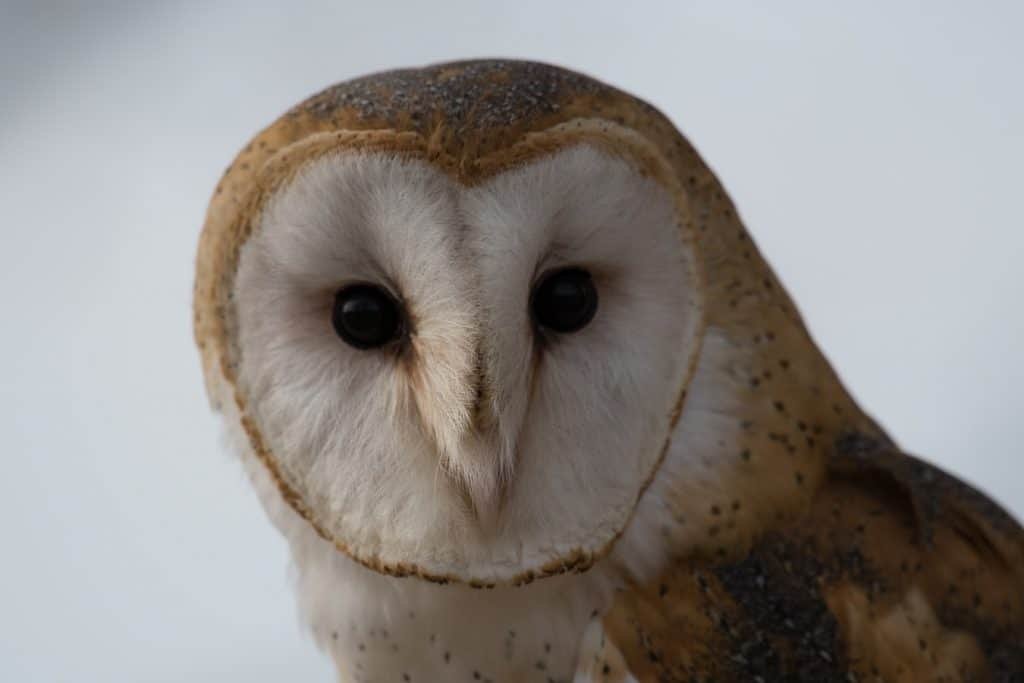
Wingspan
107 to 110 cm
Weight
430 – 620 g
Life Expectancy
Up to 4 years
Diet
Voles, Shrews & Mice
These loud little birds are known for their piercing cry that has been known to startle many a hiker at night.
These nocturnal creatures are beautiful with mottled feathers that are mostly white in color, making them fairly easy to spot if you see them.
Unlike most owls that are known for their darker appearance, the ghost-like barn owl can be spotted darting between trees.
With its mighty cry and distinguished white pallor, this owl can look fairly spooky when it heads home for its nest, which is almost always located in a nicely covered cavity.
The Barn Owl is mostly nocturnal and isn’t a fan of the blazing Arizona sun, so you won’t generally see this bird out during the day.
If you are lucky, you might spot one transitioning from one area to the next after a particularly long night of hunting.
However, their nests are often tucked away in hidden cavities, making it difficult to see them the majority of the time.
These birds are most active at night, but can sometimes be found tucked away during the day under bridges.
Maricopa County is known for its fair share of Barn Owls in Arizona.
Though you might not see them too easily during the day, night time makes it possible to get a good look at them if you are lucky.
They can be found more easily in Desert habitats, which is what makes them partial to Arizona.
There is a nice collection of small mammals for them to feast on. Look for them in Willows and Cottonwoods as well.
However, true to their name, these owls prefer structure. The Barn Owl has been known to hide in abandoned buildings, and even enjoys the odd overhang on a cliff.
2. Flammulated Owl
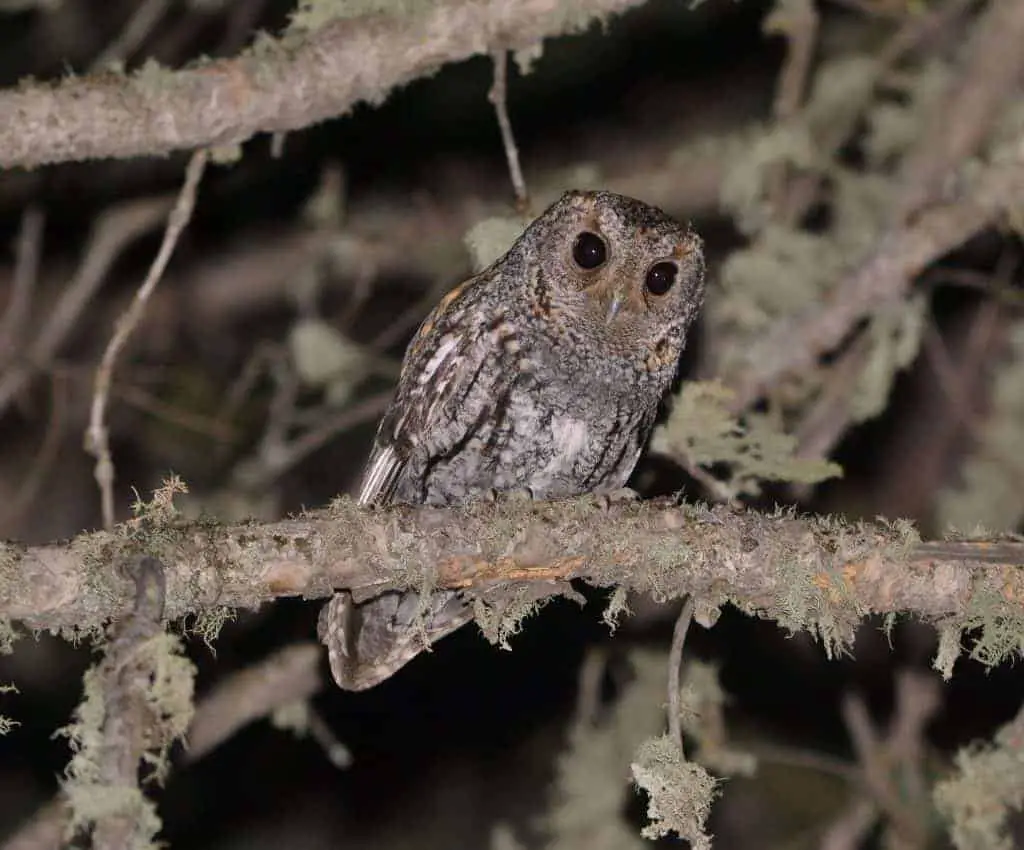
Wingspan
36 cm
Weight
50–65 g
Life Expectancy
Around 7 years
Diet
Mostly Insects
The Flammulated Owl is a unique owl that loves to play the role of pest control.
These unique birds are known for their time spent hunting insects in an area, and have been found to be very effective at controlling the local insect populations, particularly when it is warmer out.
These medium-sized owls can be found nesting in trees and are known to take over the occasional cavity for their nesting habits if time allows for it.
Spotting the Flammulated Owl in Arizona is particularly easy because Arizona has the kind of climate they prefer.
However, the numbers are known to increase in the Winter months when these unique birds are ready to head out and chase the local bug population.
Since cold weather generally means less bugs, the Flammulated Owls up north head down south for places like Arizona to find more good food to eat.
To see the Flammulated Owl, you generally want to look to the trees.
They are happiest in forests, which are known for their large amounts of vegetation. Since these unique owls like to munch on bugs, vegetation filled areas are the perfect place for them to do their hunting.
You can find them in areas with Aspen and Ponderosa trees. In Arizona, these owls are known to be spotted both north and south of Phoenix in wooded areas.
3. Great Horned Owl
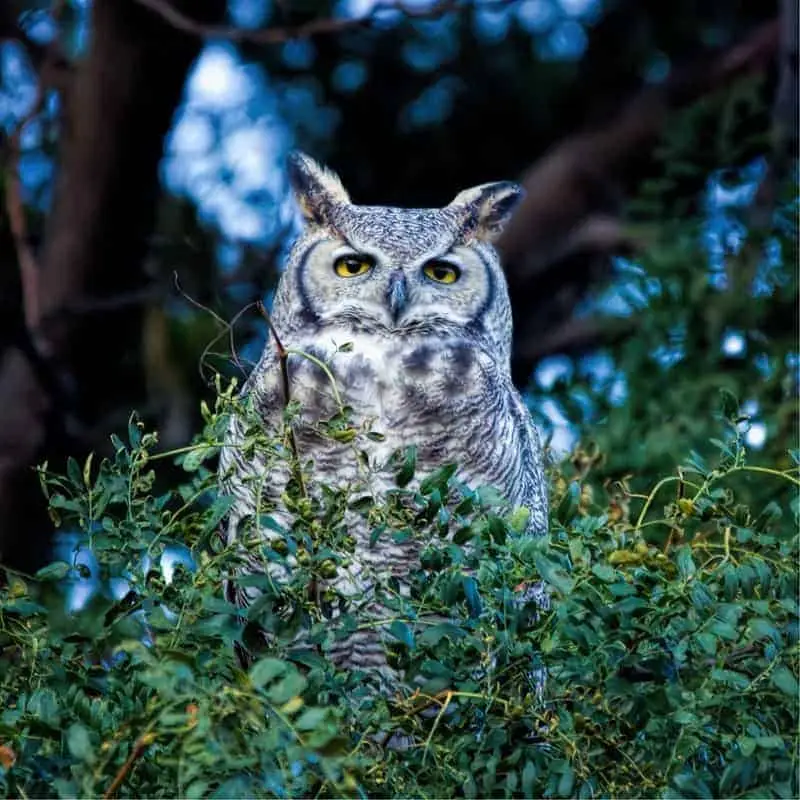
Wingspan
~140cm
Weight
1.4 kg
Life Expectancy
28 years old
Diet
Squirrels, Rabbits & Skunks
Out of all the owls in North America, the Great Horned Owl just might be the mightiest around.
This gigantic bird is known to soar through the skies and can be quite a shock to those who see it. It is large sitting down, but when this bird’s wingspan spreads, it is quite a sight to see.
This versatile creature nests in many different areas and is known for having virtually no predators aside from other Great Horned Owls.
The Great Horned Owl spends the majority of its time during the day sleeping, but they tend to wake up when evening settles in.
This unique owl prefers low light rather than complete darkness and can be found perched and scanning the area around dusk or swooping through the sky to snag a last meal first thing in the morning.
The Sonoran Desert Region is known for its vast collection of Great Horned Owls. Like most other areas, the Great Horned Owl is the biggest bird around, and it is happy to feast on a variety of different mammals in the area.
For the Great Horned Owl, anything is fair game. In addition to the local area, this wonderful owl has been known to spread itself out well across Arizona.
You can see it almost anywhere, but it does thrive in the desert area. It is bold in nature and can often be seen perched on any raised surface as it surveys the land below.
4. Whiskered Screech Owl
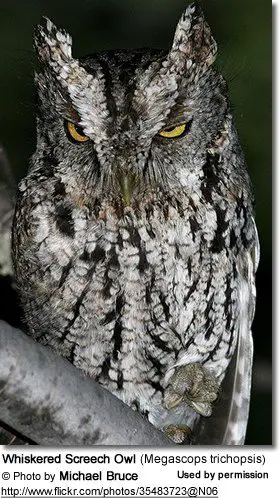
Wingspan
40-50 cm
Weight
90g
Life Expectancy
Little knowledge about the lifespan of these owls
Diet
Mostly large insects
The Whiskered Screech owl is a unique owl that graces Arizona with its presence and actually hasn’t been researched that extensively.
Whether it is simply because they are difficult to find or because they have no interest in being observed, these adorable little owls are known to be some of the more mysterious owls around.
With their pointy ears and severe expressions, they seem to imply a desire to be left alone. These owls are known to send time nesting in cavities and are often found in high numbers in their preferred areas.
The Whiskered Screech Owl is a nocturnal hunter that is not easily spotted for this reason. Unlike some owls that are known to travel throughout the year, these owls can be found in the same place year-round.
It is fairly uncommon for them to move, which means your chances are seeing them really just rely on being in the right place at the right time. Fortunately, if you manage to locate them, you can count on them to remain in the area for your next visit.
The Whiskered Screech Owl is most commonly found in southeast Arizona and some parts of New Mexico.
You can find this nocturnal predator at higher elevations, which is one of the primary reasons that so few people actually see them.
These birds can be found in wooded areas, but are known to focus on areas with a healthy supply of bugs to eat.
5. Northern Saw-whet Owl
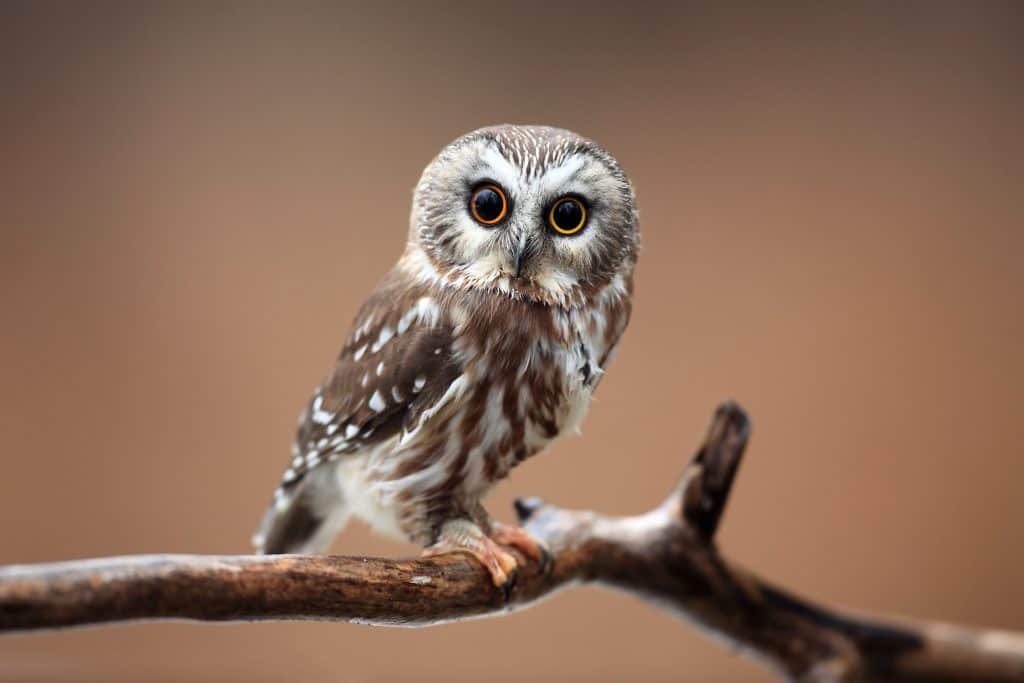
Wingspan
40 - 60 cm
Weight
100 g
Life Expectancy
7 years
Diet
Small birds, young squirrels, voles & shrews
The Northern Saw-Whet Owl is one of the cuter owls in the area, but that doesn’t mean that they don’t know a thing or two about life in the wild.
If you are looking to see a cute, smaller owl type, this is a good option if you live in the right area.
They are known for nesting in available cavities and for being fiercely territorial. Male Northern Saw-Whet Owls are known for their level of defense and will spend nights calling out to females in the area.
When it comes to spotting the Northern Saw-Whet Owl, your options are fairly opened. You can see them year-round, but they are rare a lot of the time.
However, in Winter, they are known to migrate south, which means that you have a much better chance of catching a glimpse of them.
Whether it is seeing one on the move or the owls deciding that Arizona’s nice climate is the right place to stop, these feathered friends can be spotted searching for females and hunting for food.
These owls can most commonly be found in Northern and Central Arizona at higher elevations. When it comes to finding a good place to spot them, it is generally in forested areas.
Surprisingly, you don’t see a lot of these birds in the local mountains. However, if you are camping in a nice forest during Winter, you might just be lucky enough to spot one.
6. Short-Eared Owl (Rare)
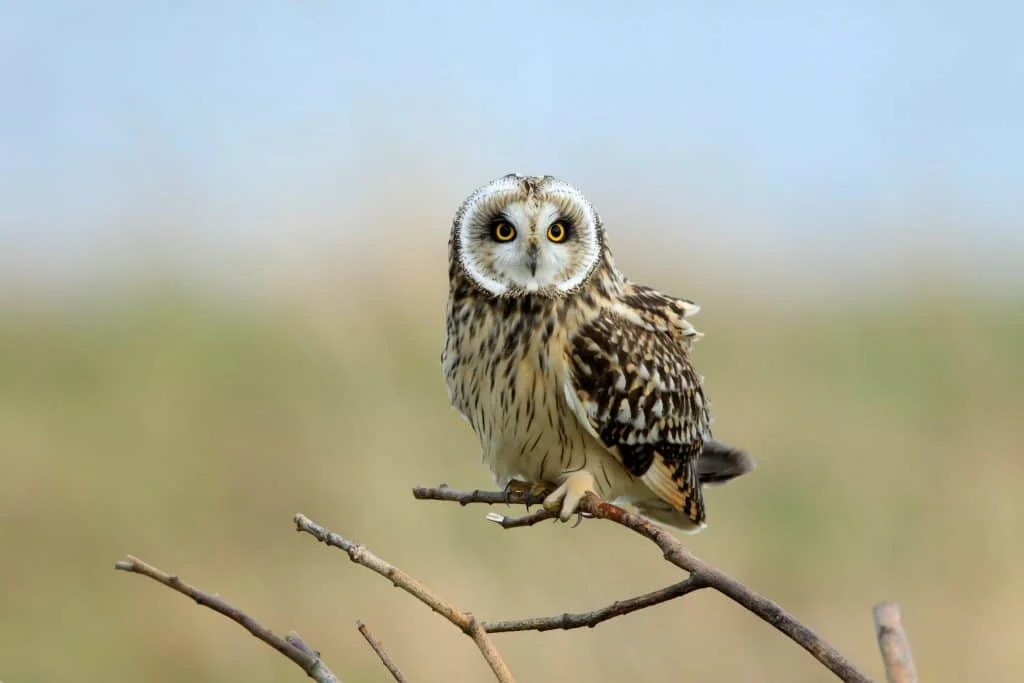
Wingspan
85 to 110 cm
Weight
206–475 g
Life Expectancy
4-12 years
Diet
Voles, Mice, Squirrels
The Short Eared Owl is an endangered owl species in many states and is known for its role in balancing ecosystems overrun with too many mammals.
These hungry birds have a recognizably round head because their tiny ears are so small that they can hardly be seen. Their low numbers make it difficult to see them unless you are in the right area.
Spotting the Short Eared Owl is often easiest at dusk. These owls are known to hunt as the sun sets low, which is lucky for birdwatchers.
If you have a Short Eared Owl in the area, you might just get lucky enough to see them as they search for food hidden away in the brush below.
Looking for the Short Eared Owl is both easy and difficult. The Short Eared Owl is a known resident of Arizona and can be found in some of the open grasslands scattered throughout the state.
The problem is that there really aren’t that many of them, so more often than not a place will have them or they won’t. Arizona residents have reported seeing multiple Short Eared Owls in one area while others can’t find at all.
It is simply a matter of being in the right place and the right time. Their nests are generally found on the ground, so you might be lucky enough to spot one when you head out for a stroll one evening.
7. Western Screech Owl
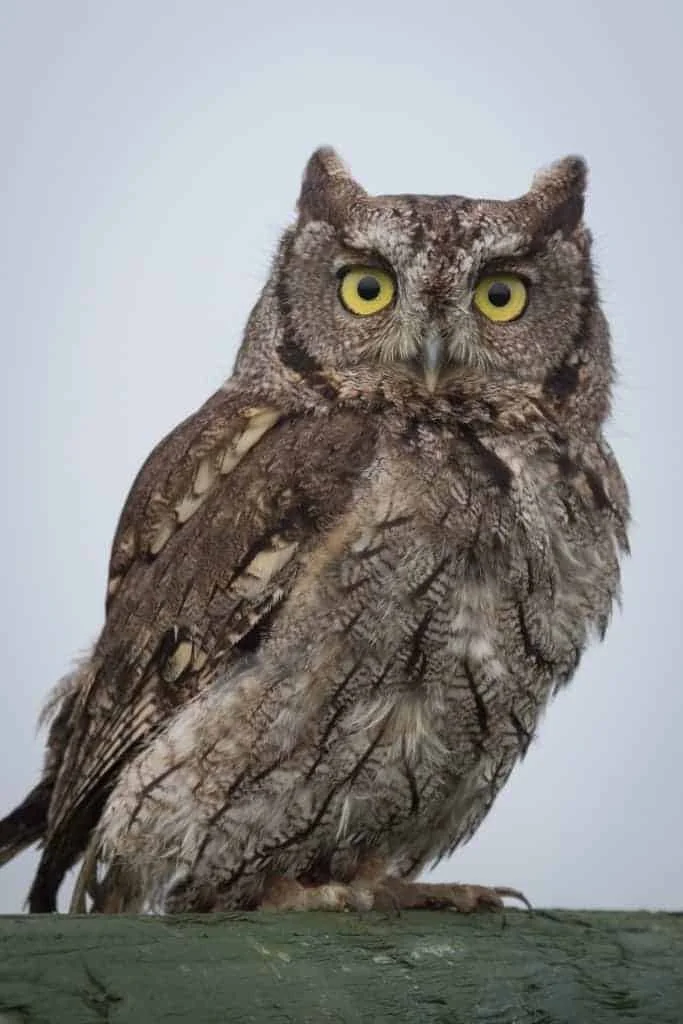
Wingspan
55 cm
Weight
143 kg
Life Expectancy
Up to 8 years
Diet
Small mammals, Mice & Birds
The Western Screech Owl is an open-minded bird that enjoys a wide variety of different food options that can really open up where it hangs out.
These smaller owls are known to spend their time nesting in cavities and have often been found in tree cavities that have been created and left behind by woodpeckers at some point.
Their second favorite place to nest includes holes left behind from broken tree branches.
However, any place of cover is generally good enough for the Western Screech Owl, which has been known to hang out in nest boxes and even underneath the occasional cliff.
The Western Screech Owl is a non-migratory bird, which means that it can be found in Arizona year-round as long as you know where to look.
These adorably round birds are nocturnal and will often hide away from the bright summer sunshine of Arizona. However, you can spot them sometimes during the day under cloudy skies.
When it comes to spotting the Western Screech Owl, it is much easier than the Whiskered Screech Owl because these birds tend to spend their time further south near more populated areas.
In Arizona, they are most commonly found in lower canyons and the areas where the desert meets the forest.
They can be found spending time in oaks and sycamores, but are known to frequent areas with plenty of small mammals to feast on.
8. Long Eared Owl
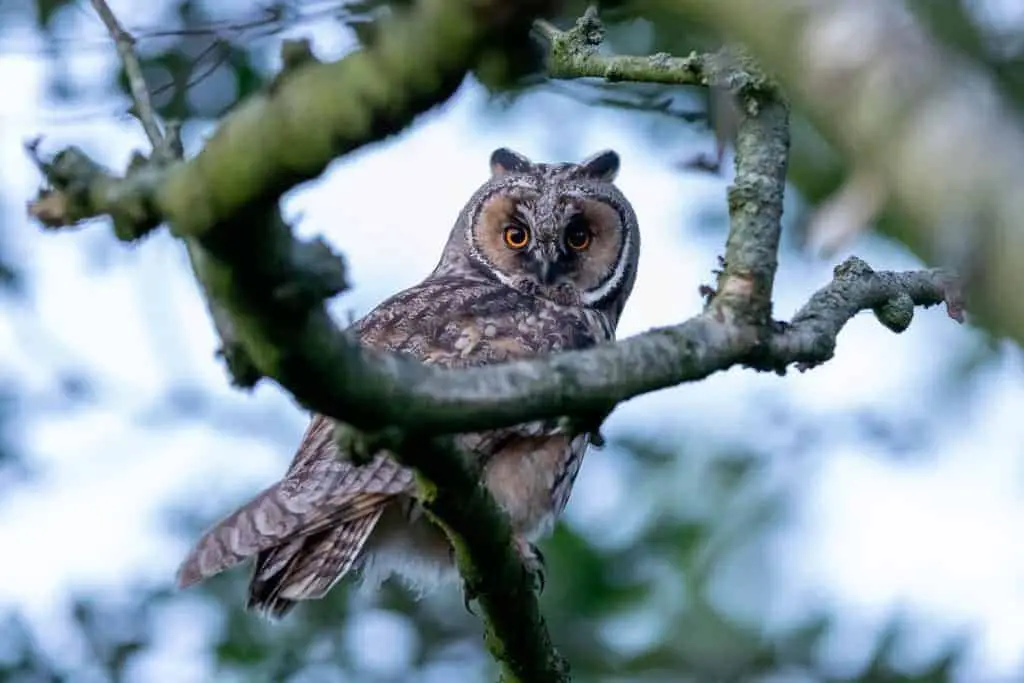
Wingspan
90 to 100cm
Weight
250 g
Life Expectancy
4 years
Diet
Small mammals, mice, rats & rabbits
When it comes to the Long Eared Owl, you can generally spot it by its unique appearance.
Its long eared name is handed over because it has longer than average ear tufts that are heightened by feathers.
It is an intimidating bird with a wingspan the size of a baby that many people find to be quite a sight.
However, their large size is also why they aren’t known for hanging out in too many populated areas.
Happy to take over any ecosystem, these birds are known for their commitment to taking over nests and soaring through the night sky.
The Long-Eared Owl is a nocturnal predator known for flying around well after dark. Its large swooping form can easily black out the moon if you are a small predator on the ground.
These birds are most active when their prey are, so if you are in the forest and find yourself surrounded by scurrying mammals, you might just be in luck.
In true large owl style, these birds are very hungry.
This means that they prefer to spend less time exploring and more time looking for their next meal.
They can be found in local forests, and have been seen by many local birdwatchers out in nature.
People have reported seeing them in Phoenix and the surrounding area, so locals might be in luck if they head out away from the main city areas.
Any area with plenty of vegetation is a preferred hunting ground for them.
9. Northern Pygmy Owl
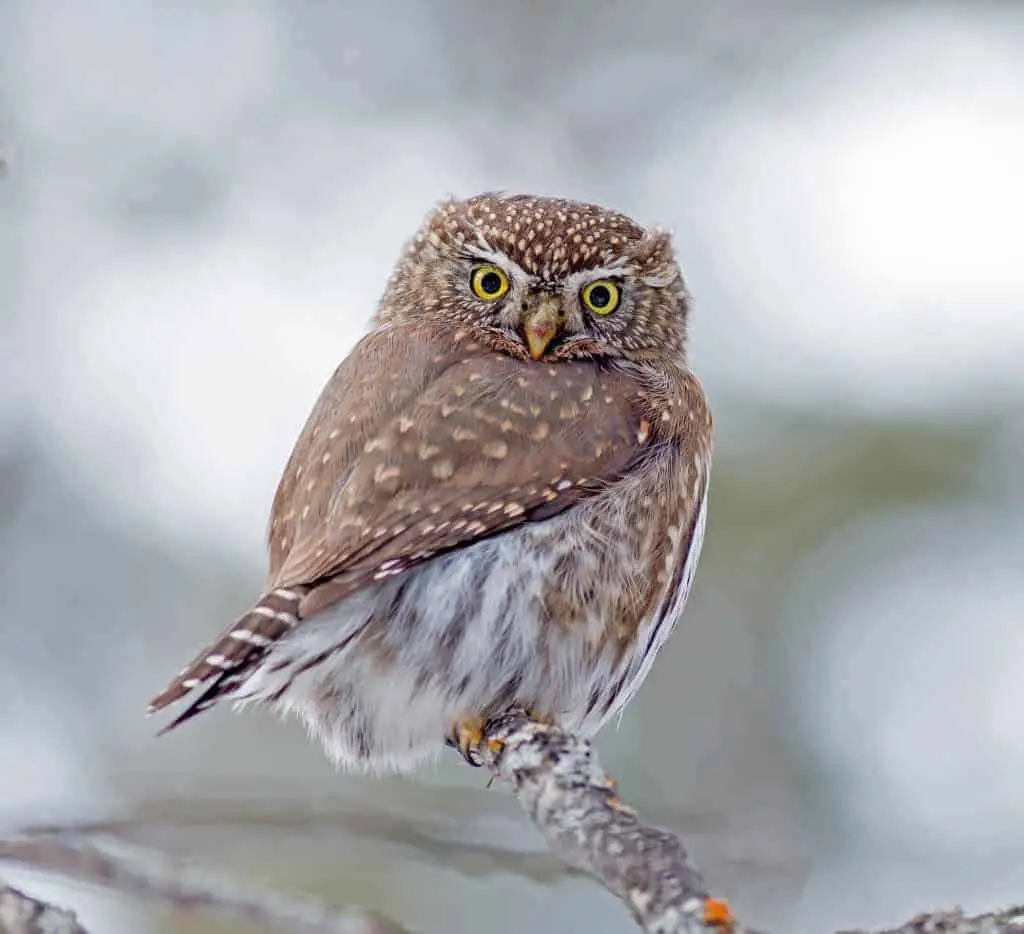
Wingspan
45 cm
Weight
300 -340 g
Life Expectancy
Up to 16 years
Diet
Rodents & Small Mammals
The Northern Pygmy Owl is one of the more adorable owls around. As its name implies, it is quite a bit smaller than some of the other owls around.
This little guy has a small and round body that makes it almost seem like a cartoon drawing of an owl compared to some of the more intimidating and larger owls that have been known to roam the ground at night.
It is known for nesting in cavities, particularly woodpecker holes and holes found in dead trees.
Spotting the Northern Pygmy Owl isn’t terribly difficult if you are in the right area. These owls, unlike most others, are actually diurnal.
This means that they are happy to spend their days flying around and hunting, which makes it much easier to spot them.
The Northern Pygmy Owl is slightly migratory depending on the weather. Though some stay put, others move to lower elevations during the Winter months.
For some people, this makes it easier to spot them during this time since they are closer to populated areas.
This tiny bundle of feathers is known for being commonly seen in southeast Arizona and can be found in wooded areas.
Areas with vegetation are good for hunting for them because these areas tend to house many of the animals that they prefer to eat.
Many people actually don’t realize that they are owls at all unless they are particularly close, but they are known to perch in trees and soar through the air looking for a nice snack.
10. Elf Owl
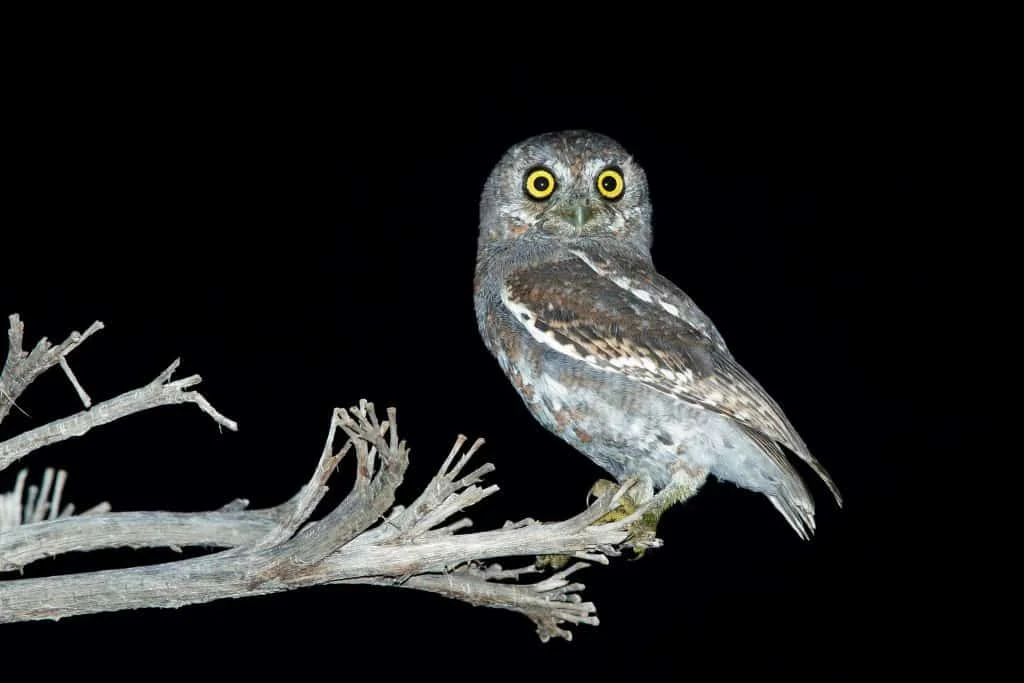
Wingspan
27 cm
Weight
40 g
Life Expectancy
3-6 years
Diet
Insects, Spiders & Scorpions
True to its name, the Elf Owl is a small owl that will stop just short of stealing your heart.
These tiny owls are some of the smallest around and are known for their uniquely miniature build and severe looks.
The Elf Owl is so small that some can fit in the palm of your hand, which is that much more amusing when you see the tiny bird with a sour expression.
The Elf Owl is known for nesting high off the ground, sometimes upwards of thirty feet. It enjoys building nests in tree cavities, but has also been found living in cavities of cacti as well.
Finding the Elf Owl in Arizona is not as difficult as you might expect, but their small forms do make them harder to see.
These nocturnal predators are known for hunting in a few different areas throughout the night, but you might be able to spot one tucked away high up in the sky during the day if you are lucky enough to find a proper nesting site.
In Winter, they have been known to leave and head to Mexico in search of more food.
The Elf Owl is most commonly found in the Sonoran Desert region, which is rich in abundance when it comes to feasting.
You can sport them diving for the ground to scoop up spiders and scorpions, much to the delight of local residents.
They are partial to water, plant-life, and cacti. Looking for a cavity in a cactus is a great way to spot them during the day.
11. Burrowing Owl
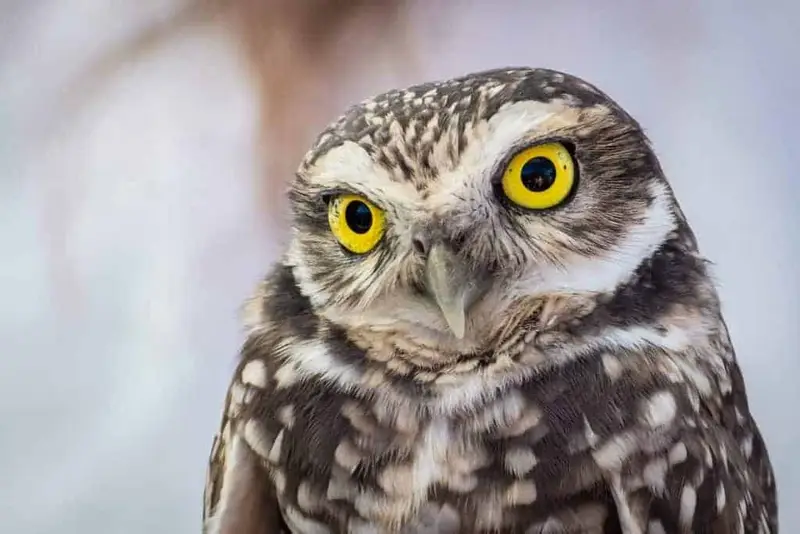
Wingspan
50.8–61 cm
Weight
140g - 240g
Life Expectancy
6-8 years
Diet
Small mammals & insects
The Burrowing Owl is an absolute treasure in the owl community and is commonly highlighted in documentaries and books.
This adorable little beast is known for the fact that it really doesn’t act like an owl at all, but rather like a small bird.
The Burrowing Owl gets its name from its burrows, which are sometimes dug, but mostly taken over after being left behind by other animals.
Burrowing Owls will nest in these burrows, which is why they are often seen perched on the ground.
Burrowing Owls are not only unique because of their burrows on the ground, but also because of the fact that they are diurnal.
The Burrowing Owl is commonly seen throughout the day, particularly when there is a lot of insect activity.
You might just find that you can easily see a Burrowing Owl while on an evening stroll in the right area.
The Phoenix Valley is known for its fair share of Burrowing Owls, making it a short drive for most people to be in their natural habitat.
Since these little guys are out during the day, you can easily venture into the area and look around in the brush for the small owl surveying the land around.
They can be seen hopping around on long legs, and it is fairly common for several of them to be in a single area.
12. Spotted Owl
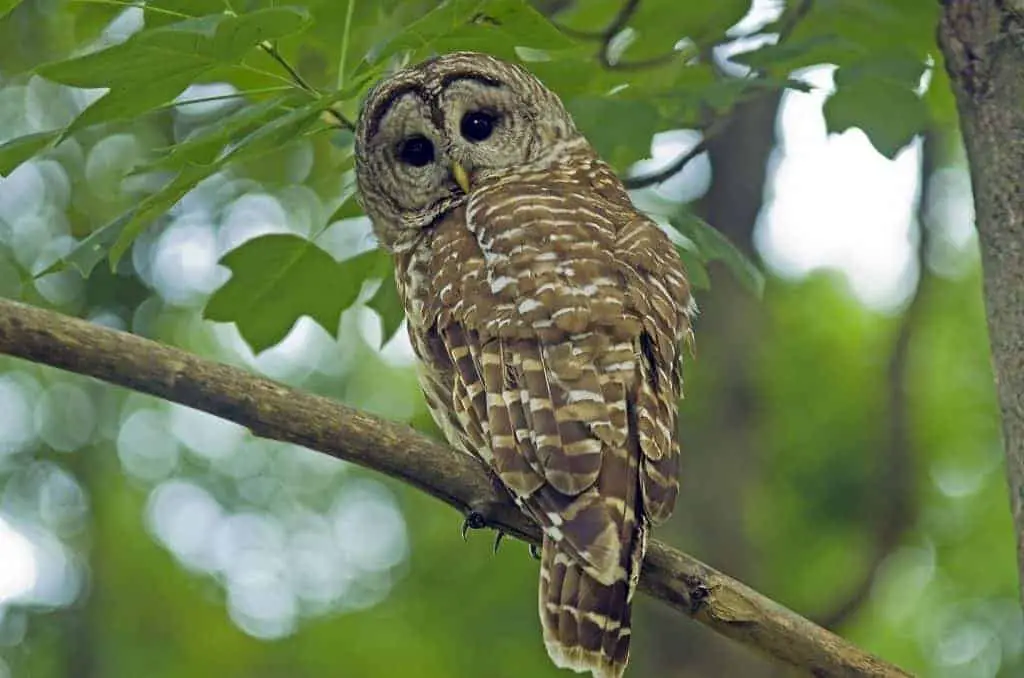
Wingspan
114cm
Weight
600g
Life Expectancy
Up to 17 years
Diet
Voles, Reptiles & Small birds
The Spotted Owl is a unique bird that is known for its signature spots.
It comes in various different colors, but the spotted appearance will always pull through no matter what their color breakdown is.
These beautiful birds are known for nesting in protected areas including tree cavities, ledges, and canyons to raise up to four eggs at a time.
Spotting the Spotted Owl is generally a matter of walking around at night.
These nocturnal predators are known to spend their night time hours hunting, but they are a lot less active than some of the other owl types with how they do it.
These owls have been known to hop around during the day as well, making it easy to spot them foraging for food.
The Spotted Owl is known for its presence in places like Arizona, Colorado, and New Mexico.
It is partial to coniferous forests and prefers to spend a lot of time amidst vegetation. Unlike other owls that spend time swooping around and scanning for prey, this unique owl prefers to wait in trees for a meal to come by.
This is why looking for them means looking up into the trees and listening for their sounds to get an idea of where they are.
13. Ferruginous Pygmy Owl (Rare)
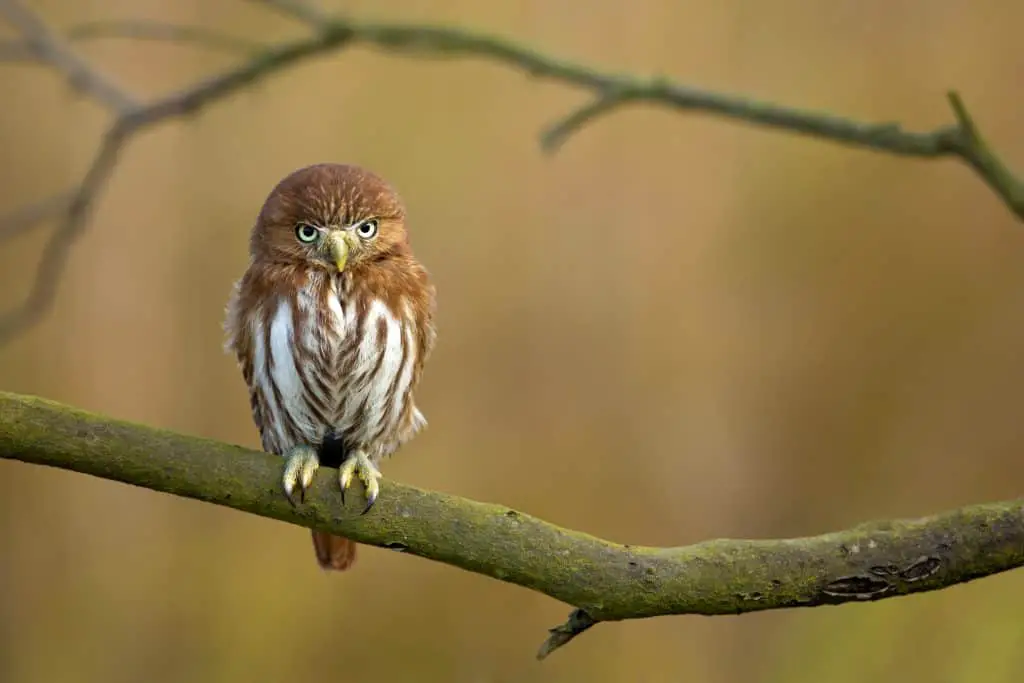
Wingspan
14.5 – 16 in
Weight
2.7 oz.
Life Expectancy
Still to be determined
Diet
Cricket, Caterpillars, Grasshoppers & Scorpions
The Ferruginous Pygmy Owl is a smaller owl with a big name that is known for spending time inside trees and cacti.
This unique owl with its striped chest pattern is happiest in a nesting cavity where it can focus on raising its young.
Whether it is a hole left behind by another bird or simply a gash left behind after a plant has experienced damage, these owls are happy to raise up to seven eggs at a time in the right nest.
Like other kinds of pygmy owls, the Ferruginous Pygmy Owl is more than happy to soak up the sunshine.
Though they do manage some hunting at night, these diurnal predators are more than pleased with spending their days hunting for fat and tasty insects.
Their fluffy exterior can be seen hovering above the ground before snatching up a delicious scorpion in broad daylight.
The Ferruginous Pygmy Owl is known to breed in central and southern Arizona and can be found in the trees as well as in desert regions depending on where the food is.
These owls can be found in high volumes nesting in trees and cacti in Winter, but are generally harder to spot since they are fairly small.
Fortunately, they don’t migrate, which makes it easier to see them year-round.

More Articles.
How to Attract Cardinals to Your Backyard: 7 Proven Tips
Attracting cardinals to your backyard is simple when you focus on their needs: food, water,
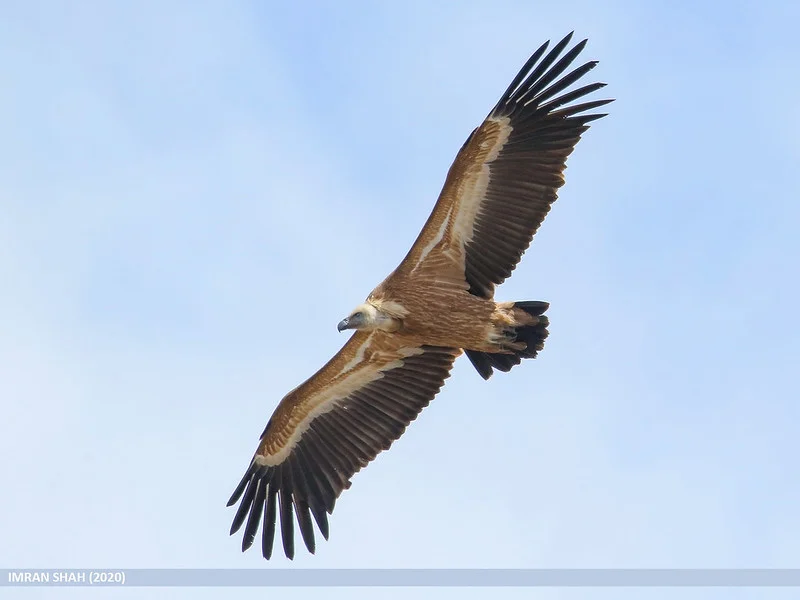
What Birds of Prey can be seen in France? (10 Species with Pictures and Sounds)
France is filled with numerous birds of prey. Its variable habitat from the mountains of

How To Attract Birds To A Balcony?
The best way to attract birds to a your balcony is to choose the correct

About Us
We are avid bird-watchers who recently retired, allowing us more time to travel the world. Fortunately, we have managed to visit numerous countries around Europe, Asia, and America. Watching and photographing birds has been a passion for many years and we are making the most of the extra time on our hands!
